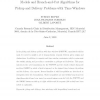Free Online Productivity Tools
i2Speak
i2Symbol
i2OCR
iTex2Img
iWeb2Print
iWeb2Shot
i2Type
iPdf2Split
iPdf2Merge
i2Bopomofo
i2Arabic
i2Style
i2Image
i2PDF
iLatex2Rtf
Sci2ools
113
Voted
NETWORKS
2007
2007
Models and branch-and-cut algorithms for pickup and delivery problems with time windows
In the pickup and delivery problem with time windows (PDPTW), capacitated vehicles must be routed to satisfy a set of transportation requests between given origins and destinations. In addition to capacity and time window constraints, vehicle routes must also satisfy pairing and precedence constraints on pickups and deliveries. This paper introduces two new formulations for the PDPTW and the closely related dial-a-ride problem (DARP) in which a limit is imposed on the elapsed time between the pickup and the delivery of a request. Several families of valid inequalities are introduced to strengthen these two formulations. These inequalities are used within branch-and-cut algorithms which have been tested on several instance sets for both the PDPTW and the DARP. Instances with up to eight vehicles and 96 requests (194 nodes) have been solved to optimality.
Related Content
| Added | 27 Dec 2010 |
| Updated | 27 Dec 2010 |
| Type | Journal |
| Year | 2007 |
| Where | NETWORKS |
| Authors | Stefan Ropke, Jean-François Cordeau, Gilbert Laporte |
Comments (0)

